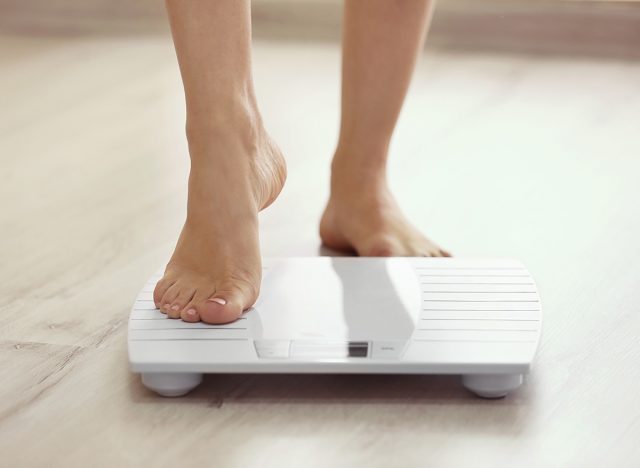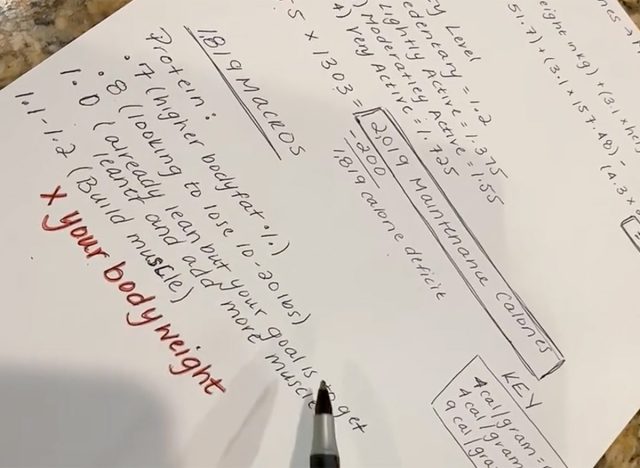#1 Way to Calculate Macros For Weight Loss Tailored to Your Body
If you are trying to lose weight, you have probably heard about counting macros – but you might not really understand what that means. According to Bri Dettlaff, body transformation coach and founder of Her Ultimate Body, calculating the numbers is quick and easy. "I'm going to teach you how to find your macros in less than three minutes," she explains in a viral video. Body Network also enlisted the expertise of The Diet Diva, Tara Collingwood, MS, RDN, CSSD, LD/N, ACSM-CPT, a Board Certified Sports Dietitian, to weigh in on the formula.
Start By Finding Your BMR

"We're going to start by finding your BMR. The number of calories your body burns at rest will help us find your maintenance calories, which will then break down into macros. You can use an online calculator," she says.
Plug in Your Weight, Height, Age

Next, plug in information. "So here's the most accurate method I found. This is the well-known equation you can use to find your BMR. So take a screenshot and do this on your own. I plugged in my weight, my height, my age, and the number of calories I burn at rest is 1303," says Bri. "This is an excellent equation and proven to be quite accurate for calculating someone's BMR," agrees Collingwood. "However, it does take some math, and many people would prefer an online calculator."
Here Is How to Get Your Maintenance Calories

"Next, you're going to do your BMR times your activity level. Sedentary would be dust job, little to no exercise, 1.2 times your BMR, lightly active exercise like one to three times a week, 1.375 times your BMR if you exercise three to five times a week, times your BMR exercise, six to seven times a week, times your BMR. So, I'm moderately active during my BMR. So 2019 calories are my maintenance calories," she continues. "I usually have people choose one of the lower activity levels and then just add what they are burning in exercise," Collingwood simplifies. "I think the higher equations can overestimate calories burned, and on days you aren't exercising, you aren't burning that much."
Here's How to Get Your Caloric Deficit

"So let's say I want to lose weight and be in a calorie deficit. I'm going to start by subtracting 100 to 200 of my maintenance calories. So for this example, I get 1,819 for my calorie deficit," says Bri. Collingwood typically recommends taking off 250 to 350 calories for weight loss. "Taking off just 100 probably won't show any results," she says. "To really see results, you need a bit more, closer to 300. The heavier the person is, the faster they can lose weight and can probably take 400-500 off each day." In general, she notes that it's hard to make this equation "one size fits all, which is why working with an individual nutrition coach who is a Registered Dietitian is the best way to get accurate calculations."
Here's How to Get Protein Macro

"Okay, time for macros. Here's a quick key I want to point out while we find our macros. Each gram of protein has four calories. Each gram of carbs has four calories. Each gram of fat has nine calories. First, we're going to choose one of these numbers based on your goals and multiply that by your body weight. So read these real quick on your own. For me, I'm already lean, but my goal is to get leaner and add more muscle. So one times my body weight equals 114 grams of protein a day. So we just found our first macro," Bri says.
Here's How to Get Fat Macro

"We're going to multiply our protein macro by four to get 456 calories. Just wait. Okay, now it's time for fat. Choose which percentage of calories you want to come from fat itself. Read these and see which one you'll align with. Then, you want to take the calorie number we found before. So, the calorie deficit number times the percentage you chose. So I chose 0.3, which gave me 545.7 calories from fat. Remember our key nine calories per gram. So you take the calories we just found divided by nine. When I got 60.6 rounded up to 61, we just found our second macro. 61 grams of fat," Bri says.
Related: 5 Types of Foods to Maximize Weight Loss on GLP-1 Medicines, According to Coach
Here's How to Calculate Carbs

"Carbs are super easy. It's your remaining calories. Remember the number we found from protein and the number we found from fat? Add them together. Subtract it from your calorie deficit. Remember our key four calories? So you divide that by four. Round it up. We've got 205 grams of carbs," she concludes. "I'm not sure where she got these calculations for macros. The numbers seem to work OK in her example, but I'm not sure they will work for everyone," says Collingwood. "Eating a gram per pound of body weight is a LOT and not necessary for the vast majority of the population. I'm afraid if people pick higher fat, they will be left with too few carbs, which is a common problem with popular weight loss diets."
💪🔥Body Booster: If you really want to lose weight and commit to fitness, consider hiring a nutritionist for a session so you can get a professional and personalized calculation of macros. And if you enjoyed this article, take advantage of these 15 Quick Ways to Lose Body Fat Percentage in a Week.
@bridettlaff I know this is a lot, but it's a commonly asked question so I went for it 😅 #macros #findyourmacros #calculateyourmacros #nutritiontips #bodytransformation #weightloss #fitnessmotivation #nutritiontips ♬ original sound – Bri





